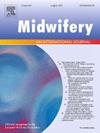求助PDF
{"title":"在比利时的助产实践中使用数字技术和应用程序:一项描述性横断面研究。","authors":"Ayse Akalin , Florence D'haenens , Joeri Vermeulen , Sandra Tricas-Sauras , Dorien Lanssens","doi":"10.1016/j.midw.2024.104218","DOIUrl":null,"url":null,"abstract":"<div><h3>Introduction</h3><div>Over the past two decades, there has been a dramatic increase in the use of digital technologies within healthcare and also in midwifery. However, scarce literature exist on the use of digital technologies and applications in midwifery practice particularly in the Belgian setting.</div></div><div><h3>Aim</h3><div>To map the use of digital technologies and applications by midwives in various settings, encompassing hospitals, primary care, and educational institutions in Belgium.</div></div><div><h3>Methods</h3><div>A descriptive cross-sectional design was used to collect data via an online questionnaire targeting at midwives working in the Flemish region, Walloon region, or Brussels-Capital region. Midwives were either Dutch-speaking or French-speaking (<em>n</em> = 212). The semi-structured questionnaire addressed three domains: (1) socio-demographics, (2) employment information (3) the use of digital technology, including the level of comfort with technology. Qualtrics© program was used for managing data and SPSS v28.0© for data analysis using descriptive statistics, Chi² analysis, and independent sample t-test. The study adhered to the Strengthening the Reporting of Observational Studies in Epidemiology reporting guidelines.</div></div><div><h3>Results</h3><div>Among respondents, 58% reported the use of digital technologies and applications, with electronic health records (89.6%), electronic prescriptions (65.6%), and remote patient monitoring (51.2%) commonly utilized. Sensor technology (7.2%), mixed care (3.8%), care robots (2.5%), and wearable devices (1.9%) were very rarely used. The target groups for these digital technologies and applications generally encompass all stages of the perinatal period. Midwives felt overall highly confident with these technologies. Younger participants and those with a Master's or PhD degree exhibited greater comfort scores in digital technology use. No significant relationships were observed between socio-demographic characteristics and the adoption of digital technology.</div></div><div><h3>Conclusion</h3><div>The results highlight the potential for incorporating digital technologies and applications into various midwifery care settings. Addressing barriers and enhancing usability can optimize technology integration, contributing to personalized high-quality care, ultimately improving perinatal health outcomes.</div></div>","PeriodicalId":18495,"journal":{"name":"Midwifery","volume":"140 ","pages":"Article 104218"},"PeriodicalIF":2.6000,"publicationDate":"2024-10-19","publicationTypes":"Journal Article","fieldsOfStudy":null,"isOpenAccess":false,"openAccessPdf":"","citationCount":"0","resultStr":"{\"title\":\"Using digital technologies and applications in midwifery practice in Belgium: A descriptive cross-sectional study\",\"authors\":\"Ayse Akalin , Florence D'haenens , Joeri Vermeulen , Sandra Tricas-Sauras , Dorien Lanssens\",\"doi\":\"10.1016/j.midw.2024.104218\",\"DOIUrl\":null,\"url\":null,\"abstract\":\"<div><h3>Introduction</h3><div>Over the past two decades, there has been a dramatic increase in the use of digital technologies within healthcare and also in midwifery. However, scarce literature exist on the use of digital technologies and applications in midwifery practice particularly in the Belgian setting.</div></div><div><h3>Aim</h3><div>To map the use of digital technologies and applications by midwives in various settings, encompassing hospitals, primary care, and educational institutions in Belgium.</div></div><div><h3>Methods</h3><div>A descriptive cross-sectional design was used to collect data via an online questionnaire targeting at midwives working in the Flemish region, Walloon region, or Brussels-Capital region. Midwives were either Dutch-speaking or French-speaking (<em>n</em> = 212). The semi-structured questionnaire addressed three domains: (1) socio-demographics, (2) employment information (3) the use of digital technology, including the level of comfort with technology. Qualtrics© program was used for managing data and SPSS v28.0© for data analysis using descriptive statistics, Chi² analysis, and independent sample t-test. The study adhered to the Strengthening the Reporting of Observational Studies in Epidemiology reporting guidelines.</div></div><div><h3>Results</h3><div>Among respondents, 58% reported the use of digital technologies and applications, with electronic health records (89.6%), electronic prescriptions (65.6%), and remote patient monitoring (51.2%) commonly utilized. Sensor technology (7.2%), mixed care (3.8%), care robots (2.5%), and wearable devices (1.9%) were very rarely used. The target groups for these digital technologies and applications generally encompass all stages of the perinatal period. Midwives felt overall highly confident with these technologies. Younger participants and those with a Master's or PhD degree exhibited greater comfort scores in digital technology use. No significant relationships were observed between socio-demographic characteristics and the adoption of digital technology.</div></div><div><h3>Conclusion</h3><div>The results highlight the potential for incorporating digital technologies and applications into various midwifery care settings. Addressing barriers and enhancing usability can optimize technology integration, contributing to personalized high-quality care, ultimately improving perinatal health outcomes.</div></div>\",\"PeriodicalId\":18495,\"journal\":{\"name\":\"Midwifery\",\"volume\":\"140 \",\"pages\":\"Article 104218\"},\"PeriodicalIF\":2.6000,\"publicationDate\":\"2024-10-19\",\"publicationTypes\":\"Journal Article\",\"fieldsOfStudy\":null,\"isOpenAccess\":false,\"openAccessPdf\":\"\",\"citationCount\":\"0\",\"resultStr\":null,\"platform\":\"Semanticscholar\",\"paperid\":null,\"PeriodicalName\":\"Midwifery\",\"FirstCategoryId\":\"3\",\"ListUrlMain\":\"https://www.sciencedirect.com/science/article/pii/S0266613824003012\",\"RegionNum\":3,\"RegionCategory\":\"医学\",\"ArticlePicture\":[],\"TitleCN\":null,\"AbstractTextCN\":null,\"PMCID\":null,\"EPubDate\":\"\",\"PubModel\":\"\",\"JCR\":\"Q1\",\"JCRName\":\"NURSING\",\"Score\":null,\"Total\":0}","platform":"Semanticscholar","paperid":null,"PeriodicalName":"Midwifery","FirstCategoryId":"3","ListUrlMain":"https://www.sciencedirect.com/science/article/pii/S0266613824003012","RegionNum":3,"RegionCategory":"医学","ArticlePicture":[],"TitleCN":null,"AbstractTextCN":null,"PMCID":null,"EPubDate":"","PubModel":"","JCR":"Q1","JCRName":"NURSING","Score":null,"Total":0}
引用次数: 0
引用
批量引用


